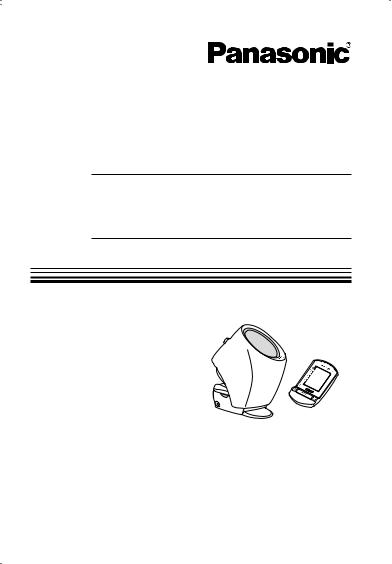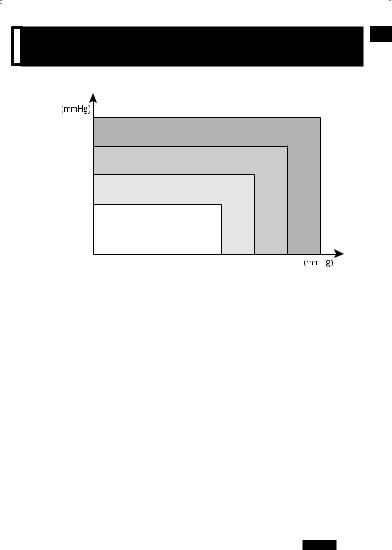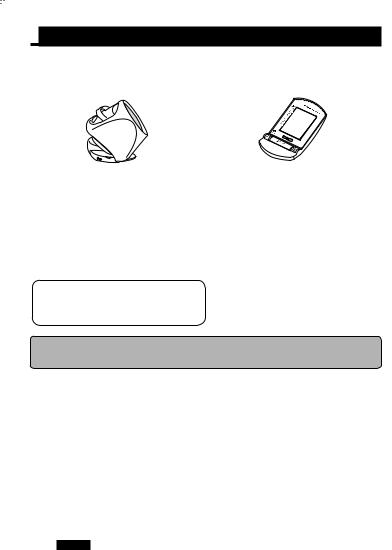Panasonic EW3153, EW3153W User Manual

Instructions
Upper Arm Blood Pressure
Model EW3153
Before operating this device, please read these instructions completely and save this manual for future use.

Panasonic Oscillometric Diagnostec™ Automatic Arm Blood Pressure Monitor Model EW3153 is a device intended to measure systolic and diastolic blood pressure and pulse rate of an adult individual by using a pressurized cuff on the arm. The device is not intended for use on infants and children. The device is designed for home use only, not for ambulatory measurement (measurement recorded continuously during the day).
Specification of this device including pulse rate (30–160 pulse/min. +/– 5%) are listed in page 29.
Blood pressure measurements determined with this device are equivalent to those obtained by a trained observer using the cuff/ stethoscope auscultation method, within the limits prescribed by the American National Standard, Manual, Electronic or automated sphygmomanometers.
If you suffer from disorder of heart rhythm, known as arrhythmia only use this blood pressure monitor in consultation with your doctor. In certain cases oscillometric measurement method can produce incorrect readings.
Flashing System for hypertensive readings are based on blood pressure values classified in the paper: “JNC 7 Express; The Seventh Report of the Joint National Committee on Prevention, Detection, Evaluation and Treatment of High Blood Pressure; U.S. DEPARTMENT OF HEALTH AND HUMAN SERVICES; National Institute of Health; National Heart, Lung, and Blood Institute; National High Blood Pressure Education Program; NIH Publication No. 03-5233; May 2003.” The display values are generally known, but not proven, to be an indicator of your blood pressure.
The EW3153 is not intended to be used as a diagnostic device. Contact your physician if prehypertensive or hypertensive values are indicated.
English

Table of Contents |
|
Introduction ............................................................................................... |
3 |
Basics of Blood Pressure .......................................................................... |
3 |
Important Instructions Before Use ............................................................ |
4 |
Precautions to Ensure Safe, Reliable Operation ....................................... |
6 |
Easily Check Your Blood Pressure Readings Against |
|
the JNC 7* Classification ........................................................................... |
8 |
Preparations Prior to Taking Measurements ............................................. |
9 |
Parts Identification ................................................................................... |
10 |
When Using the Main Unit with the AC Adapter ..................................... |
11 |
When Using the Main Unit with Batteries ................................................ |
12 |
Inserting the Batteries into the Wireless Display ..................................... |
13 |
Setting the Time and Date ....................................................................... |
14 |
Taking a Reading .................................................................................... |
15 |
Storing and Calling up Blood Pressure Readings ................................... |
24 |
Comparing AM and PM Average Systolic Blood Pressure ...................... |
27 |
After Use ................................................................................................. |
28 |
Specifications .......................................................................................... |
29 |
Q & A ....................................................................................................... |
30 |
Care and Maintenance ............................................................................ |
32 |
Troubleshooting ....................................................................................... |
33 |
English



 Introduction
Introduction
Thank you for purchasing the Panasonic Automatic Arm Blood Pressure Monitor EW3153.
Measuring your own blood pressure is an important way of monitoring your health. High blood pressure (hypertension) is a major health problem which can be treated effectively once detected. Measuring your blood pressure between doctor visits on a regular basis in the comfort of your home, and keeping a record of the measurements, will help you monitor any significant changes in your blood pressure. Keeping an accurate record of your blood pressure will help your doctor diagnose and possibly prevent any health problems in the future.

 Basics of Blood Pressure
Basics of Blood Pressure
Your heart acts like a pump, sending blood surging through your blood vessels each time it contracts. Blood pressure is the pressure exerted by blood pumped from the heart on the walls of blood vessels. Systolic pressure is the pressure exerted when the heart contracts and pumps blood into the arteries. Diastolic pressure is the pressure exerted when the heart expands, or relaxes. When you or your doctor take your blood pressure, both your systolic and diastolic pressures are measured. If your blood pressure measurement is 120 mmHg over 80 mmHg (120/80), for example, your systolic pressure is 120 mmHg while your diastolic pressure is 80 mmHg.
English


 Important Instructions Before Use
Important Instructions Before Use
1.Do not confuse self-monitoring with self-diagnosis. Blood pressure measurements should only be interpreted by a health professional who is familiar with your medical history.
2.If you are taking medication, consult with your physician to determine the most appropriate time to measure your blood pressure. NEVER change a prescribed medication without first consulting with your physician.
3.Blood pressure can vary based on many factors, including age, gender, weight and physical condition. In general, a person’s blood pressure is lower during sleep and higher when he or she is active. Blood pressure can change easily in response to physiological changes. The setting in which a person’s blood pressure is measured can also affect the results. Having one’s blood pressure measured by a healthcare professional in a hospital or clinic can cause nervousness and may result in a temporarily elevated reading. Because blood pressure measurements taken in a clinical setting can vary considerably from those taken at home, a person’s blood pressure should be measured not only occasionally in the doctor’s office, but also on a regular basis at home. Also, if you find that your blood pressure is lower at home, this is not unusual. To accurately compare with your physician’s reading, take your Panasonic blood pressure monitor to your doctor’s office and compare readings in this setting.
4.People suffering from cardiac arrhythmia, vascular constriction, liver disorders or diabetes, people with cardiac pacemakers or a weak pulse, and women who are pregnant should consult their physician before measuring their blood pressure themselves. Different values may be obtained due to their condition.
5.Try to take your blood pressure measurements at the same time and under the same conditions every day.
•The ideal time to measure your blood pressure (to obtain your socalled “base blood pressure”) is in the morning just after waking up, before having breakfast and before any major activity or exercise. If this is not possible, however, try to take measurements at a specified time prior to breakfast, and before you have become active. You should relax for about 5 minutes before taking the measurement.
•The following situations may cause substantial variations in blood pressure readings and should therefore be avoided at least
English

30 minutes prior to taking your blood pressure. Blood pressure will be higher than usual:
-when you are excited or tense
-when you are taking a bath
-during exercising or soon after exercising
-when it is cold
-within one hour after eating
-after drinking coffee, tea or other beverages containing caffeine
-after smoking tobacco
-when your bladder is full
-when in a moving vehicle
Blood pressure will be lower than usual:
-after taking a bath
-after drinking alcohol
6.Measurements may be impaired if this unit is used near a television, microwave oven, X-ray equipment or other devices with strong electrical fields. To prevent such interference, use the unit at a sufficient distance from such devices or turn the devices off.
7.This unit is designed for use by adults. Consult with your physician before using this unit on a child. Do not use on infants or toddlers.
8.This unit is not suitable for continuous monitoring during medical emergencies or operations.
9.Do not use the unit for any purpose other than measuring blood pressure. Do not use the unit together with other devices.
10.Improper handling of batteries may result in battery rupture or in corrosion from battery leakage. Please observe the following to ensure proper use of batteries.
a.Be sure to turn off the power after use.
b.Do not mix different types or sizes of batteries.
c.Change all batteries at the same time. Do not mix old and new batteries.
d.Be sure to insert batteries with correct polarity, as instructed.
e.Remove batteries when they are worn out, and dispose of them properly according to all applicable environmental regulations.
f.Do not disassemble batteries or throw them into a fire.
g.Do not short-circuit batteries.
h.Do not attempt to recharge the batteries included with the unit.
English


 Precautions to Ensure Safe, Reliable Operation
Precautions to Ensure Safe, Reliable Operation
1.Do not drop the unit. Protect it from sudden jars or shocks.
2.Do not insert foreign objects into any openings.
3.Do not attempt to disassemble the unit.
4.If the unit has been stored at temperatures below 0 °C (32 °F), leave it in a warm place for about 15 minutes before using it. Otherwise, the cuff may not inflate properly.
5.Do not store the unit in direct sunlight, high humidity or dust.
6.When cleaning, unplug the AC adapter from the AC outlet before cleaning. Also, do not plug in or unplug the AC adapter with wet hands. Doing so may result in electric shock or fire.
7.Do not spill water on the main unit, wireless display or AC adapter. Doing so may cause electric shock, short-circuiting, or product damage.
8.Do not use the AC adapter if it is damaged or if it plugs into the AC outlet loosely. Doing so may result in electric shock or short-circuiting.
9.If the product does not operate properly or seems strange, stop use and unplug the AC adapter immediately, and request inspection and service. Failure to do so could result in the risk of an accident, electric shock, or fire.
10.When using the AC adapter, make sure it is fully inserted into the AC outlet. Failure to do so could result in electric shock or short-circuiting.
11.When the product is not in use, unplug the AC adapter from the AC outlet. Failure to do so could result in deterioration of the insulation due to dust or moisture, causing a leakage electricity fire.
12.When unplugging the AC adapter, do not pull on the cord. Always grasp the AC adapter body and unplug it. Failure to do so could result in the risk of electric shock, short-circuiting, or fire.
13.Do not insert any object in the AC adapter or allow debris to collect on it. Doing so could result in the risk of electric shock, short-circuiting, or fire.
14.Do not scratch, damage, modify, forcibly bend, pull, or twist the AC adapter cord. In addition, do not place heavy objects on top of the cord
English

or pinch it with objects. Do not wrap the cord around the main unit and the AC adapter. Doing any of these things may result in the risk of fire or electric shock.
15.Do not step on the AC adapter. Doing so may cause an accident or injury.
16.Do not use a voltage converter. Doing so may cause fire or electric shock.
17.This AC adapter is designed for use only with Panasonic Blood Pressure Monitor, model EW3153. Use with other electrical devices may result in death or serious personal injury.
18.ALWAYS unplug the AC adapter from the power outlet before performing maintenance.
19.Do not let this product to be used by children.
20.Do not let this product to be used by people who cannot express their feelings, or who cannot operate the product by themselves. Do not use the unit on an arm where a catheter has been inserted. Such use may result in an accident or injury.
21.Use AC adapter only with electrical outlet of voltages marked on name plate. For use in the U.S.A., use AC adapter only with AC 120 V electrical outlet. Use with electrical outlets at other voltages may results in the risk of fire, electric shock, or burns.
22.Do not allow any material to drape over the AC adapter. Doing so could result in the risk of fire.
23.Do not modify or attempt to repair the product or AC adapter by yourself.
Doing so could result in the risk of fire, electric shock, or personal injury.
English

Easily Check Your Blood Pressure Readings Against the JNC 7* Classification
Blood Pressure Categories
(DBP) |
|
Stage 2 Hypertension |
e.g.: SBP 165 |
|
|
Pressure |
100 |
|
|
DBP 105 |
|
Stage 1 Hypertension |
e.g.: SBP 150 |
|
|||
90 |
|
|
DBP 95 |
|
|
|
|
|
|
||
Blood |
Prehypertension e.g.: SBP 130 |
|
|||
80 |
DBP 85 |
|
|||
Normal e.g.:SBP 115 |
|
|
|
||
Diastolic |
|
DBP 75 |
|
|
|
|
|
|
|
|
|
|
|
|
120 |
140 |
160 |
Systolic Blood Pressure (SBP)
If the two blood pressure measurements (systolic, diastolic) fall into separate categories, your level is classified in the higher of the two categories. For example, a Stage 2 systolic reading, but a diastolic pressure reading in the normal range.
*JNC 7: The Seventh Report of the Joint National Committee on Prevention, Detection, Evaluation and Treatment of High Blood Pressure National Institute of Health (NIH) Publication; No. 03-5233, May 2003
IMPORTANT:
•Do not be alarmed by temporarily high or low readings because fluctuations in a person’s blood pressure are not uncommon. If possible, measure and record your blood pressure at the same time every day, and consult your physician if you have questions or concerns.
•If abnormal variations in blood pressure are observed in measurement, please consult your physician.
English



 Preparations Prior to Taking Measurements
Preparations Prior to Taking Measurements
To use this product, the power supplies are required for both the main unit and the wireless display.
Main unit |
Wireless display |
Power supply
•Exclusive AC adapter (EW31555) (included) or
•4 AA-size Panasonic LR6 batteries Approximately 150 measurements can be taken.
Depending on the conditions, battery life may be dramatically shorter.
Use of the main unit with the dedicated AC adapter (EW31555) (included) is recommended.
Power supply
•2 AA-size LR6 batteries Approximately 2000 measurements can be taken.
Main unit and wireless display are not sold separately and cannot be purchased as replacement parts.
For Batteries
•Unit with batteries can be used up to 6 times a day when using Panasonic Alkaline batteries (AA-sized LR6 batteries) under the following conditions:
Room temperature: 73 °F (23 °C) Pressurized to 170 mmHg
Circumference of the arm: 11-51/64 (30 cm)
•If batteries other than alkaline batteries are used or batteries are used in a room colder than 73 °F (23 °C), and when measuring a person with thin arms or high blood pressure, battery life may be dramatically shortened.
*Use alkaline batteries. (Panasonic Oxyride batteries can also be used.)
English


 Parts Identification
Parts Identification
Main unit
1 Measuring section Pressure cuff
2 Battery cover for main unit
Battery cover for main unit
Bottom of main unit
View from Top
Power cord |
AC adaptor |
|
 Plug
Plug
3IR transmitter (on both sides)
4Connector
5Arm support
The angle of this product can be adjusted so that measurements can be taken without having to be in a forced posture.
Elbow rest
6Quick air release button
7Handle
8On/Off and Start button
AC Adapter (EW31555) (included)
English 10
